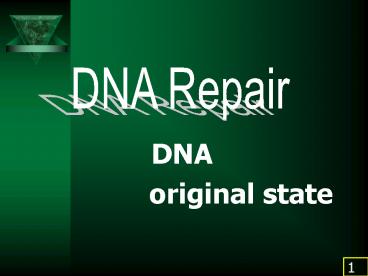DNA PowerPoint PPT Presentation
1 / 24
Title: DNA
1
DNA Repair
- ??????? DNA ??????????
- ?????????? original state
2
Mechanisms ??? DNA Repair
- I. True repair ????? defective DNA ???????
- 1. Direct reversal mechanism ????
- Directly undoing DNA damage
- 2. Excision repair
- 3. Mismatch repair
- II. Non-repair method ??????? defective DNA
- 4. Recombination repair
- 5. Error-prone repair system
3
1. Direct Reversal Mechanism
- ????????????????????????? ????Directly undoing
DNA damage - 1.1 Light-dependent repair /
- Photoreactivation
- 1.2 O6- methylguanine methyltransferase
4
1.1 UV damage repair / Light repair
- Pyrimidine dimer (TT) ????????????? UV
???????????????????????? ???????? (light gt 300
nm) - ??? photoreactivating enzyme ???? DNA photolyase
- ??? activate enzyme ?????? TT dimer ???
- ???? bacteria, microbial eukaryote ??????
5
(No Transcript)
6
1.2 Direct reversion ??? Methylation / Ethlyation
- ??????? DNA ??? ??? methylation ???? ethylation
- O6- methylguanine methyltransferase ??? methyl
???? ethyl group ??? Guanine ?? DNA - Enzyme ????? sulfur atom ??? cystein ??????????
methyl ???? ethyl ???? enzyme ???????????? ????
suicide enzyme ???????????????????? - ??????????? E. coli ??? human
7
O6- methylguanine methyltransferase
8
2. Excision Repair
- ???????????????? damaged DNA ?????????? fresh DNA
segment ????????? - Excision repair ???? repair ????????????????
?????????????? mechanisms - 2.1 Base excision repair
- 2.2 Nucleotide excision repair
9
2.1 Base excision repair
- ??? damaged base ?????????? DNA glycosylase
- ??? AP site
- 1) DNA glycosylase ??? damaged base ??????
- glycosidic bond ??? sugar ???????? base AP
site - (Apurinic ???? Apyrimidinic sites)
- 2) AP endonuclease ??? Phosphodiesterase ???
- sugar-phosphate group ???
- 3) DNA polymerase ??? base ??????????
- 4) DNA ligase ?????? 2 nucleotides ?????????
10
- Abnormal base
- Glycosylase ??? base --gt AP site
- AP endonuclease ??? sugar-PO4
- DNA polymerase refills new base
- DNA ligase seals nick
11
2.2 Nucleotide excision repair
- ??? abnormal bases ??????? ???? TT dimers ????
base ????? side group ???????? - ???? E. coli ??? human
- 1) Excision nuclease (Exonuclease) ???
oligonucleotide (12 mers) ????? damaged bases ???
- 2) DNA polymerase I fills gap
- 3) DNA ligase seals nick
12
- Excision nuclease ????????????? 3 genes ???
- UvrA,
- UvrB ???
- UvrC
13
3. Mismatch Repair
- Mismatch ??????????? replication ?????
- (1) ??? base ???
- (2) failure ??? proofreading system
- ??????? repair ???? replication ???? T G
????????? - Parental strand ?? base ????
- Progeny strand ?? mismatched base
- ???????????????? methylation ??? base ?? ???
pogeny ???????????????????????????? T ???? G ???
14
- ??? A ?? GATC sequence ????? methylated ??? 250
base pairs ???? replication - ???????????? methylation ????? pogeny --gt
mismatch repair system ??????????????????????
methyl ??? mismatched base ????????? progeny ????
??????? methylate - Prokaryote ??? Eukaryote ?? mismatch repair
system ????????
15
- Mismatch repair ?? E. coli ?? proteins ??? 4
genes - mutH, mutL, mutS ??? mutU ( uvrD)
- MutH protein ?? GATC-specific endonuclease
activity ?????? GATC ??? ?????? methylated ????
5 ???? 3 ?? 100 nt --gt ??? gap - DNA pol fills gap ???
- DNA ligase seals nick
16
(No Transcript)
17
4. Recombination Repair(Postreplicative Repair)
- Repair mechanism ?????????????? ???????????? DNA
replication ???? ??? repair ??? ??? system
????????????? - ????? DNA pol III replicate ????? TT dimer
????? DNA replication ???????????? ????
replication ??????? dimer ???? primer ???? ???
duplex
18
- ???? Replication --gt 2 ??? sister - double
helices - Damaged double helix Sister double helix
(normal) parent strand ?? TT (1) normal parental
strand (3) progeny strand ?? gap (2) normal
progeny strand (4)
19
- Recombination repair ???????? ??? progeny ????
gap - Gapped strand (2) ??? damaged duplex ?? cross ???
- parent strand (3) ??? normal double duplex
- ?????? nucleotides ??? (3) ???????? gap ??? (2)
- ??? T T (1) ?????? ????????? repair ????????
nucleotide - excision repair system ???? ????? repair
- ??? gapped (2) ???????
- Parent strand (3) ??? sister duplex ?? gap --gt
filled ???? DNA pol I DNA ligase --gt sister
duplex (3 4) ???????
20
- Recombination ??????? RecA protein ??? recA gene
- RecA protein ????????? exchange single strand
??????? homologous double helices ?? homologous
recombination ????????
21
5. Error-prone (SOS) Repair
- ????????????????????? ? ??? mutagents ???? UV
light ?????????????????????????? ??? SOS response - SOS response ?????????? DNA repair ???????,
recombination, ?????????? proteins ????????
replication - Error-prone repair
- ???? ???????????? SOS response
- ???? replication ??? DNA pol ?????? base ???????
damaged segment ??? template strand - ????????????? 2 proteins ??? umuC umuD (UV
mutable) genes
22
- DNA damage ??????? induce pathway
- (1) mutagen ???? UV damages DNA --gt activate
recA gt RecA ???? protease ?????????? targets - (2) RecA ???? LexA ???? repressor ???? genes
- --gt LexA ??????? genes ??? repressed ???????????
???? umuDC operon - (3) umuDC operon active --gt transcription --gt
- translation ??? UmuD UmuC
- (4) UmuD UmuC ????? DNA pol ??????? ? damaged
- site replication ????? ?????? base ???
??????? GC ??????? TT ??? replication
??????????????
23
- Error-prone repair ???? ???????????? replication
??? damaged sites ?????? base ??? - UV activates RecA
- RacA cleaves LexA
- umuDC operon trnscribes
- UmuC UmuD ?????? DNA replicate ??? bases ??????
T T dimer
24
DNA Damage, Repair Cell Function

